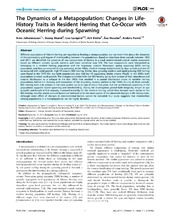| dc.description.abstract | Different populations of Atlantic herring are regarded as forming a metapopulation, but we know little about the dynamics of the connectivity and degree of interbreeding between the populations. Based on data from three periods between 1962 and 2011, we identified the presence of two components of herring in a small semi-enclosed coastal marine ecosystem based on different somatic growth patterns and mean vertebrae sum (VS). The two components were interpreted as belonging to a resident herring population and the migratory, oceanic Norwegian spring spawning (NSS) herring population, and they co-occurred during spawning. In the 1960s, resident herring characterized by slow growth and low VS co-occurred with rapid growth, high VS oceanic NSS herring. Similar slow-growing resident and rapid-growing NSS herring were found in the 1970–80s, but both populations now had low VS suggesting similar origins. Finally, in the 2000s both populations showed rapid growth. The changes coincided with the NSS herring going from a state of high abundance and oceanic distribution to a collapse in the late 1960s that resulted in a coastal distribution closer to resident herring populations, before full recovery and resumption of the migratory, oceanic pattern in the 1990s. During all three periods, NSS herring were only present in the local system up to an age of about five years, but the synchronous spawning of the populations supports mixed spawning and interbreeding. During the investigation period both longevity, length at age (growth) and length-at-first maturity increased markedly for the resident herring, which then became more similar to the NSS herring. Genetic and/or cultural factors are believed to be the main causes of the observed changes in life history traits, although some effect of changes in environmental factors cannot be excluded. Our study suggests that relationships among populations in a metapopulation can be highly dynamic. | en_US |

